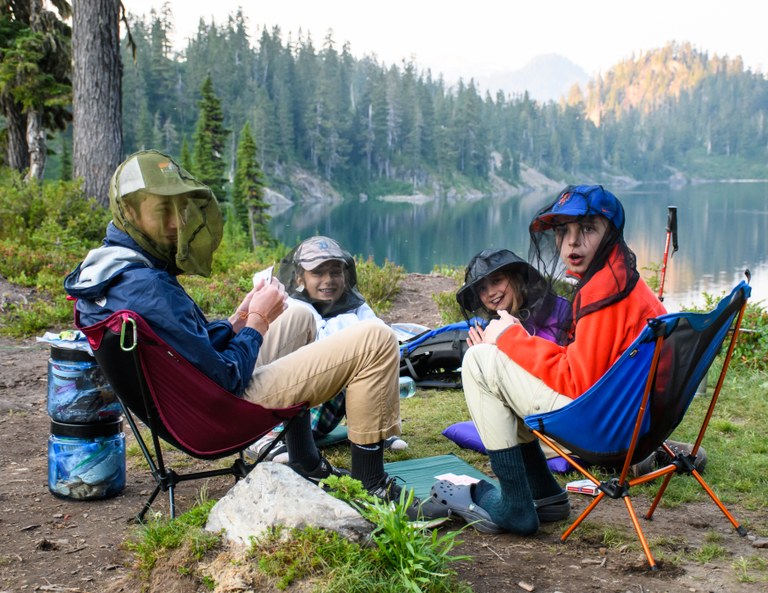 Washington Trails
Association
Washington Trails
Association
Trails for everyone, forever
Take a seat and learn everything you need to know about which hiking chair is right for you. By Sandra Saathoff
Eventually, you have to sit. Oh, that may not be your goal for the adventure — or maybe it is — but in between all the hiking and sleeping is a section of time for sitting. You need to eat, relax, filter water or whatnot.
You can always pull up a patch of dirt or find yourself a log. That’s a completely legit option and one many of us have done for years. But if you want to get a little more elaborate and comfortable, read on as we look at some of the popular options for taking a load off.
But first, some general features you’ll want to consider when choosing what you’re going to sit on.
Let’s start our discussion of seats with minimalist options. With a little luck, nature provides. A rock or a patch of dirt with a log for a backrest can make a good chair. To improve upon what nature has provided, use gear you’re already carrying. You can add the ground sheet for under your tent or a piece of sheet foam packing material, also lightweight. To go one step up from this, use a foam sit pad to cushion your derriere on nature’s furniture. (Slightly less simple: You can add a backrest frame that your pad slips into, although you’ll still be on the ground.)

A soft frame for a camp pad can add some back support while you rest. It does keep you on the ground, though. Photo by Janine Griggs
Other things you may already have with you include a hammock, if you’re a hammock sleeper. Affix it to a couple of trees and you have a comfortable napping or lunch break spot.
Your backpack may also be an option. I say “may” because only some backpacks are sturdy and well-padded enough that you’d actually want to sit on them. My lightweight backpack never gets sat upon, but I do often stop for a break with my pack still on, settle onto the ground and use the pack as a backrest.
If you’re willing to consider carrying an actual chair, for the cost of one pound of extra weight (and around $150), you can step into heaven. To ultralight backpackers, the thought of adding weight is sacrilege. I used to feel that way, too. But then my friends and I met two women section-hiking the PCT. When they pulled out their chairs, I realized that it might be worth a second look. I haven’t looked back. My chair is my luxury item.

Sometimes it's the little things — like catching sunset in comfort. Photo by Jingwen Yu
Camp chairs are often made up of a frame of aluminum poles held together with shock cord, with the poles inserted into a hard plastic base. The seat is generally ripstop polyester, nylon or a similar fabric.
If you’re picking a chair to improve your backcountry experience, it’s important to make sure it’s, well, comfortable. Here are a few factors to consider.
One other thing to keep in mind once you’re ready to use your chair is that ground support matters. If the ground is squishy, the chair feet will sink in, which can lead to an unplanned plop on the ground while you’re trying to relax.

There are a few different chair options on the market, so consider what you'll be using it for — even if it's relaxing with friends! Photo by Jeff Lewis
A camp stool is an option, though the lack of a seat back may take away the joy of a chair. However, there are lightweight tripod stools available that are constructed similarly to the chairs, which weigh between 12 ounces and 18 ounces for about the same cost as a chair.
If you have the ability to try a bunch of chairs at your local outdoor store, you can determine for yourself which option has that perfect combination of features/weight/price.
Penny pincher tip: Wait for mid-year or end-of-year sales. Then it’s just a matter of tucking the chair into a pocket on your backpack or strapping it to the top and hiking into the wilderness, enjoying the anticipation of sipping your morning coffee from the comfort of your new best friend! Happy trails!